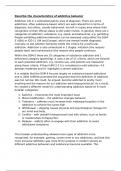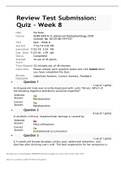Exam (elaborations)
A* Answers for Addiction EDUQAS A-Level PSYCHOLOGY
- Institution
- WJEC
Component 3 Eduqas/WJEC Psychology - Implications in the real world All describe and evaluate questions and answers Includes all methods of modifying, biological explanations, social explanations and individual differences explanations FOR ADDICTION
[Show more]




